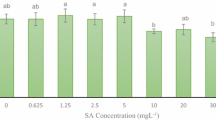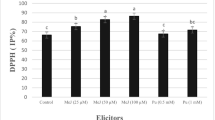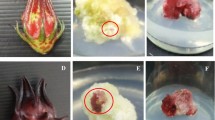Abstract
Callus from Opuntia streptacantha (cv. Tuna loca), Opuntia megacantha (cv. Rubí reina), and Opuntia ficus-indica (cv. Rojo vigor) were exposed to jasmonic acid (JA) and abiotic stress (drought and UV light) to improve the metabolite production. The callus growth curves, phenolic acids and flavonoids content, antioxidant activity and phenylalanine ammonia lyase (PAL) activity were analyzed under normal and stress conditions. In O. streptacantha callus, the phenolics concentration increased 1.6 to 3 times times in presence of 5% PEG or after irradiation with UV light for 240 min, respectively, while flavonoids triplicate with UV light. A significant increase in antioxidant activity was observed in calli from the three Opuntia species in media with 50 µM JA. The relationships between metabolites/PAL activity, and metabolites/antioxidant activity were analyzed using a surface response methodology. Results showed that PAL activity, induced with PEG and UV, correlated with flavonoids content in O. megacantha and O. ficus-indica calli; PAL activity was related to both flavonoids and phenolics compounds in O. ficus-indica and O. megacantha calli exposed to JA, but only to flavonoids in O. streptacantha callus. In general, the JA stimulated simultaneously the metabolic pathways for phenolics and flavonoids synthesis, while abiotic stress induced mainly flavonoids route. As the stressed Opuntia calli exhibited as high antioxidant activity as cladodes, they are a promising system for research on antioxidant biosynthesis and/or to identify new compounds with antioxidant properties.






Similar content being viewed by others
References
Abdullahil Baque M, Lee E, Paek K (2010) Medium salt strength induced changes in growth, physiology and secondary metabolite content in adventitious roots of Morinda citrifolia: the role of antioxidant enzymes and phenylalanine ammonia lyase. Plant Cell Rep 29:685–694
Astello-García MG, Robles-Martínez M, Barba-de la Rosa AP, Santos-Díaz MS (2013) Establishment of callus from non-domesticated species Opuntia robusta Wendl. and phenolics compounds production. Afr J Biotechnol 12:3204–3207
Astello-García MG, Cervantes I, Nair V, Reyes-Agüero A, Santos-Díaz MS, Guéraud F, Negre-Salvayre A, Rossignol M, Cisneros-Zevallos L, Barba-de la Rosa AP (2015) Chemical composition and phenolic compounds profile of Opuntia ssp. cultivars with different domestication grade. J Food Compos Anal 43:119–130
Baenas N, Garcia-Viguera C, Moreno D (2014) Elicitation: a tool for enriching the bioactive composition of foods. Molecules 19:13541–13563
Blum A (2008) Use of PEG to induce and control plant water deficit in experimental hydroponics culture. Focus on form: Retrieved from http://www.plantstress.com/methods/PEG.htm
Caruso M, Curro S, Las Casas G, La Malfa S, Gentile A (2010) Microsatellite markers help to assess genetic diversity among Opuntia ficus-indica cultivated genotypes and their relation with related species. Plant Syst Evol 290:85–97
Chaonan Li, Carl KYN, Liu-Min F (2015) MYB transcription factors, active players in abiotic stress signaling. Environ Exp Bot 114:80–91
Crupi P, Pichierri A, Basile T, Antonacci D (2013) Postharvest stilbenes and flavonoids enrichment of table grape cv Redglobe (Vitis vinifera L.) as affected by interactive UV-C exposure and storage conditions. Food Chem 141:802–808
Dikilitas M (2012) Purification of phenylalanine ammonia lyase (PAL) and peroxidase (POX) enzymes obtained from lucerne (Medicago sativa L. cv. Vertus) following inoculation with Verticillium albo-atrum. J Res Biol 2:355–361
Dixon RA, Pavia NL (1995) Stress-induced phenylpropanoid metabolism. Plant Cell 7:1085–1097
Ferrari S (2010) Biological elicitor of plant secondary metabolites: mode of action and use in the production of nutraceutics. In: Giardi MT, Rea G, Berra B (eds) Bio-farms for nutraceuticals: functional food and safety control by biosensors, chapter 12. Springer, New York, pp 152–166
Gadzovska S, Maury S, Delaunay A, Spasenoski M, Joseph C, Hagege D (2007) Jasmonic acid elicitation of Hypericum perforatum L. cell suspensions and effects on the production of phenylpropanoids and naphtodianthrones. Plant Cell Tiss Organ Cult 89:1–13
Garoby-Salom S, Guéraud F, Camaré C, Barba-de la Rosa AP, Rossignol M, Santos-Díaz MS, Salvayre R, Negre-Salvayre A (2016) Dietary cladode powder from wild type and domesticated Opuntia species reduces atherogenesis in apoE knock-out mice. J Physiol Biochem 72:59–70
Hao G, Jiang X, Feng L, Tao R, Li Y, Huang L (2016) Cloning, molecular characterization and functional analysis of a putative R2R3-MYB transcription factor of the phenolic acid biosynthetic pathway in S. miltiorrhiza Bge. f. alba. Plant Cell Tiss Organ Cult 124:151–168
Inostroza-Blancheteau C, Reyes-Díaz M, Arellano A, Latsague M, Acevedo P, Loyola R, Arce-Johnson P, Alberdi M (2014) Effects of UV-B radiation on anatomical characteristics, phenolic compounds and gene expression of the phenylpropanoid pathway in highbush blueberry leaves. Plant Physiol Biochem 85:85–95
Karabourniotis G, Liakopoulos G, Nikolopoulos D, Bresta P, Stravroulaki V, Sumbele S (2014) Carbon gain vs. water saving, growth vs defense: two dilemas with soluble phenols as a joker. Plant Sci 227:21–27
Keller J, Camaré C, Bernis C, Astello-García M, Barba-de la Rosa AP, Rossignol M, Santos-Díaz MS, Salvayre R, Negre-Salvayre A, Guéraud F (2015) Antiatherogenic and antitumoral properties of Opuntia cladodes: inhibition of low density lipoprotein oxidation by vascular cells, and protection against the cytotoxicity of lipid oxidation product 4-hydroxynonenal in a colorectal cancer cellular model. J Physiol Biochem 71 (3):577–587
Kováčik J, Bačkor M (2007) Phenylalanine ammonia-lyase and phenolic compounds in chamomile tolerance to cadmium and copper excess. Water Air Soil Pollut 185:185–193
Meda A, Lamien CE, Romito M, Millogo J, Nacoulma OG (2005) Determination of the total phenolic, flavonoid and proline contents in Bukinafasan honey as well as their radical scavenging activity. Food Chem 91:571–577
Perez-Alonso N, Capote A, Gerth A, Jiménez E (2012) Increased cardenolides production by elicitation of Digitalis lanata. Plant Cell Tiss Organ Cult 110:153–162
Pichereaux C, Hernández-Domínguez EE, Santos-Díaz MS, Reyes-Agüero A, Astello-García M, Guéraud F, Negre-Salvayre A, Schultz O, Rossignol M, Barba-de la Rosa AP (2016) Comparative shotgun proteomic analysis of wild and domesticated Opuntia spp. species shows a metabolic adaptation through domestication. J Proteom 143:353–364
Piga A (2004) Cactus pear: a fruit of nutraceutical and functional importance. JPACA 6:9–22
Prasch CM, Sonnewald U (2015) Signaling events in plants: stress factors in combination change the picture. Environ Exp Bot 114:4–14
Ramakrishna A, Ravishankar GA (2011) Influence of abiotic stress signals on secondary metabolites in plants. Plant Signal Behav 6:1720–1731
Renuka S, Balusamy D, Rahimi S, Sukweenadhi J, Kim YJ, Yang DC (2015) Exogenous methyl jasmonate prevents necrosis caused by mechanical wounding and increases terpenoid biosynthesis in Panax ginseng. Plant Cell Tiss Organ Cult 123:341–348
Reyes-Agüero JA, Aguirre Rivera JR, Flores Flores JL (2005) Variación morfológica de Opuntia (Cactacea) en relación con su domesticación en la Altiplanicie Meridional de México. Interciencia 30:476–484
Rizzo AM, Berselli P, Zava S, Montorfano G, Negroni M, Corsetto P, Berra B (2010) Endogenous antioxidants and radical scavengers. In: Gigardi MT, Rea G, Berra B (eds) Bio-farms for nutraceuticals: functional food and safety control by biosensors, chapter 5. Springer, New York, pp 52–67
Robles-Martínez M, Barba-de la Rosa AP, Guéraud F, Negre-Salvayre A, Rossignol M, Santos-Díaz MS (2016) Establishment of callus and cell suspensions of wild and domesticated Opuntia species: study on their potential as a source of metabolite production. Plant Cell Tiss Organ Cult 124:181–189
Santos-Díaz MS, Ochoa Alejo N (1994) Effect of water stress on growth, osmotic potential and solute accumulation in cell cultures from chili pepper (a mesophyte) and creosote bush (a xerophyte). Plant Sci 96:21–29
Santos-Zea L, Gutierrez-Uribe JA, Serna-Saldivar SO (2011) Comparative analyses of total phenols, antioxidant activity, and flavonol glycoside profile of cladode flours from different varieties of Opuntia spp. J Agri Food Chem 59(13):7054–7061
Su H, Jiang H, Li Y (2015) Effects of PAL and ICS on the production of total flavonoids, daidzein and puerarin in Pueraria thomsonii Benth suspension cultures under low light stress. J Plant Biochem Biotechnol 24:34–41
Swiatek A, Lenjou M, Van Bockstaele D, Inze D, Van Onckelen H (2002) Differential effect of jasmonic acid and abscisic acid on cell cycle progression in tobacco BY-2 cells. Plant Physiol 128:201–211
Trivedi S, Galiba G, Sankhla N, Erdei L (1991) Responses to osmotic and NaCl stress of wheat varieties differing in drought and salt tolerance in callus cultures. Plant Sci 73:227–232
Waterhouse AL (2002) Determination of total phenolics. In: Wrolstad RE (ed) Current protocols in food analytical chemistry. Wiley, New York
Way HM, Kazan K, Mitter N, Goulter KC, Birch RG, Manners JM (2002) Constitutive expression of a phenylalanine ammonia-lyase gene from Stylosanthes humilis in transgenic tobacco leads to enhanced disease resistance but impaired plant growth. Physiol Mol Plant Pathol 60:275–282
Yua KW, Gaob W, Hahna EJ, Paek KY (2002) Jasmonic acid improves ginsenoside accumulation in adventitious root culture of Panax ginseng C.A. Meyer. Biochem Eng J 11:211–215
Zou DM, Brewer M, Garcia F, Feugang JM, Wang J, Zang R, Liu H, Zou CP (2005). Cactus pear: a natural product in cancer chemoprevention. Nutr J 4:25
Acknowledgements
The authors are grateful to CONACYT for the Grant No. 142873 (Bilateral Mexico-France Project) and for the fellow no. 247838 to NG Camarena-Rangel.
Author information
Authors and Affiliations
Corresponding author
Rights and permissions
About this article
Cite this article
Camarena-Rangel, N.G., Barba-De la Rosa, A.P., Herrera-Corredor, J.A. et al. Enhanced production of metabolites by elicitation in Opuntia ficus-indica, Opuntia megacantha, and Opuntia streptacantha callus. Plant Cell Tiss Organ Cult 129, 289–298 (2017). https://doi.org/10.1007/s11240-017-1177-8
Received:
Accepted:
Published:
Issue Date:
DOI: https://doi.org/10.1007/s11240-017-1177-8




